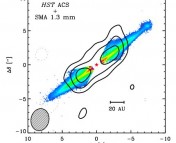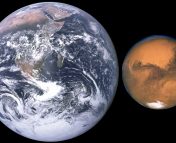Title: The aeolian-erosion barrier for the growth of metre-size objects in protoplanetary-discs
Authors: Mor Rozner, Evgeni Grishin, Hagai B. Perets
First Author’s Institution: Technion – Israel Institute of Technology, Haifa, Israel
Status: Accepted to MNRAS, preprint on arxiv
To become a terrestrial planet, you’ve gotta start small. Terrestrial worlds, like those found in the inner solar system, are thought to have been constructed via the gradual accumulation of tiny (micron-sized) dust grains. Over hundreds of thousands of years, these grains bump into each other, stick together and build progressively larger bodies. First come pebbles (cm-sized), then planetesimals (meter-sized), embryos (Moon-sized) and finally planets.
For this picture to work, however, a number of potential growth barriers must be somehow overcome. Laboratory experiments show that mm-sized objects don’t like to stick together when they collide, and if they do manage to stick, they are rather easy to break apart. Furthermore, the headwind experienced by slightly larger (meter-sized) bodies as they plow through the gas in a protoplanetary disk tends to force planet-building material to fall onto the star in only a few thousand years (much shorter than the time it takes to build a planet)!
Despite how overwhelmingly difficult and unlikely it might seem for a tiny dust grain to eventually grow into a planet, there are many proposed solutions to these growth barriers. Most of these involve accumulating material so quickly that the growth barriers essentially don’t matter. In particular, if enough dust can concentrate together locally, the timescale to grow big can beat out the typical timescales to fall onto the star or shatter into tiny pieces. A theory known as the streaming instability, in which dust becomes so concentrated that it starts to push back against the gas in the protoplanetary disk, has been gaining a lot of recent attention and is often used to explain how asteroid-sized and larger bodies in the solar system managed to form.
The authors of today’s paper examine yet another (commonly overlooked) barrier to growth, known as the aeolian-erosion barrier. Here, aeolian-erosion simply refers to the breakdown and transport of solid materials by wind. This mechanism, which is also used to explain how sand dunes move and evolve on worlds like Mars and Titan, is likely to be at play as planet-forming material orbits through a much slower moving disk of gas. As pebbles and planetesimals cut through the dense primordial gas, aeolian-erosion acts to eat away at the outer layers of these bodies.
Like dust in the wind
To understand aeolian-erosion, the authors construct an analytic model to study how this process should operate on planet building material in a typical protoplanetary disk. The goal of this work is to place this erosion process into context with other mechanisms that operate in a planet-forming disk. In particular, the authors seek to understand how the timescale for aeolian-erosion compares with other growth processes. Additionally, the authors are interested to determine what size of bodies erosion might create.

Although aeolian-erosion inevitably wears bodies down, there are limits to what it can do. First, the relative velocity between the gas and a body will decrease as the gas streams past, due to aerodynamic drag. This drag force becomes more effective as the body shrinks in size and creates a lower limit (around 10cm), below which erosion ceases to really do much. Additionally, the gas in the disk has a finite lifetime. After ~1 Myr, most of the gas will have evaporated and the remaining gas should be incredibly tenuous.
Both of these limitations are reflected in Figure 1, which shows the size evolution of rocky bodies of various initial radii. Although smaller bodies erode almost immediately, they quickly drop below the threshold velocity and remain at a size of 10 cm. The largest bodies require a much longer amount of time to erode. Some never even manage to reach the threshold size before the gas disk evaporates. This is especially true when the self-gravity of the bodies (shown by the dashed lines) is taken into account. Here, the self-gravity provides some additional help to hold planetesimals together as the gas wind tries to eat away at their outer layers.
Destruction lends a helping hand
Although aeolian-erosion appears quite effective at wearing down a wide range of bodies to pebble size, this isn’t entirely bad news for our bottom-up (gradual evolution from small to big) planet formation theory. As mentioned before, these smaller pebbly bodies will be strongly coupled to the gas and should spiral inwards toward the star. A theory known as pebble accretion predicts that this dense inward flux of pebbles can rain down onto any interior planets that are forming, and is actually a highly effective way to grow a terrestrial planet, or even build the core of a gas giant. Aeolian-erosion appears to produce bodies that are just the right size for pebble accretion to really take off.
Additionally, aeolian-erosion might be helpful for triggering the streaming instability, which is a way to quickly skip over all of the aforementioned growth barriers. The streaming instability tends to work best when particles are small and uniform in size. Erosion naturally produces a population of bodies that meet this criteria.
When considering these ‘barriers to growth’, it’s important to keep in mind that these are often only bad news for a homogeneous, slowly evolving protoplanetary disk. Although easier to model, nature’s endless and often unexpected complexity can provide solutions to what may seem like an insurmountable problem. In the case of this study, a process that wears planet-building material down and inhibits growth might actually be the key to explaining how things like radial drift, bouncing and fragmentation are actually overcome!




